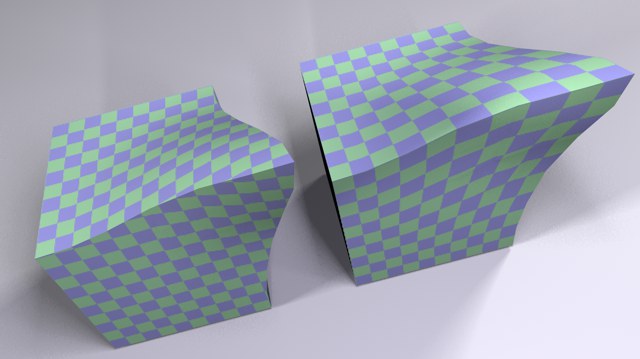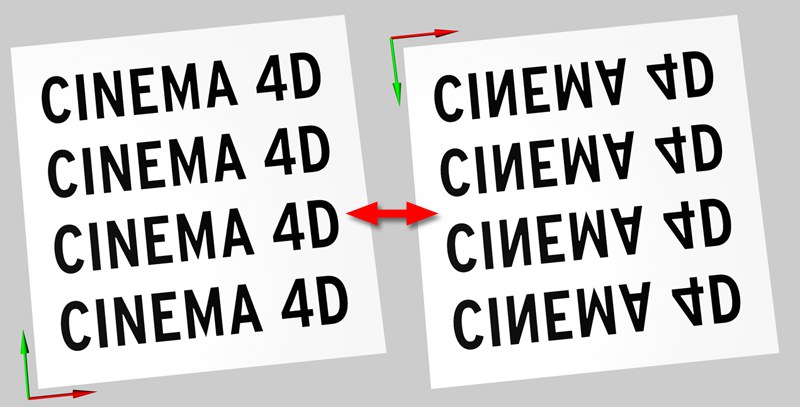
Texture Tag Menu
纹理标签菜单
生成 UVW 坐标
Tip: 提示:You can use this command to generate UVW coordinates. This is especially useful for imported objects that do not have UVW coordinates. UVW coordinates prevent a texture from slipping when you deform the object. You generate UVW coordinates starting from a normal projection mode such as Flat.
您可以使用此命令生成 UVW 坐标。这对于没有 UVW 坐标的导入对象特别有用。UVW 坐标防止纹理滑动时,你变形的对象。您可以从普通投影模式(如 Flat)开始生成 UVW 坐标。
生成 UVW 坐标

The effect of UVW coordinates is demonstrated in the picture above. The object to the left uses Cubic mapping. The texture slips when the object is deformed. The texture for the object to the right does not slip since its original cubic mapping has been fixed in place with UVW coordinates.
UVW 坐标的效果如上图所示。左边的对象使用立方映射。当物体变形时,纹理会滑动。对象的纹理不会滑动,因为它的原始立方体映射已经固定到位与 UVW 坐标。
You may use multiple Material tags on an object, with each Material tag assigned to a different UVW tag. To do this, add a new Material tag to the object and set the desired projection type, such as flat mapping for a label. Next, choose Generate UVW coordinates. A new UVW geometry will be created and the selected Material tag will switch over to UVW mapping so that the texture is fixed to the object’s surface.
您可以对一个对象使用多个 Material 标记,每个 Material 标记分配给不同的 UVW 标记。为此,向对象添加一个新的 Material 标记,并设置所需的投影类型,例如标签的平面映射。接下来,选择生成 UVW 坐标。一个新的 UVW 几何图形将被创建,选中的材质标签将切换到 UVW 映射,以便纹理被固定到对象的表面。
Each time Generate UVW Coordinates is used, a new UVW tag will appear in the Object Manager. A Material tag will use the first UVW tag that appears anywhere to the right of it in the tag list. If no UVW tag exists to the right of the Material tag, then the Material tag will use the first UVW tag on the tag list. In this way, different UVW tags can be assigned to different Material tags.
每次使用 generateuvw 坐标时,一个新的 UVW 标记将出现在对象管理器中。Material 标记将使用出现在标记列表中其右侧任何位置的第一个 UVW 标记。如果 Material 标记右侧没有 UVW 标记,那么 Material 标记将使用标记列表中的第一个 UVW 标记。通过这种方式,可以为不同的 Material 标记分配不同的 UVW 标记。
See UVW tag.
参见 UVW 标签。
Note also that faulty projections can result if the geometry of the object to which the texture is applied is not subdivided sufficiently. In such cases you should increase the object’s subdivision.
还要注意,如果将纹理应用到的对象的几何形状没有被充分细分,就会导致错误的投影。在这种情况下,应该增加对象的细分。
分配 UVW 坐标
This command enables you to texture an object with several different projection types using a single UVW geometry and a single Material tag.
使用这个命令,您可以使用单个 UVW 几何体和单个 Material 标记对具有多种不同投影类型的对象进行纹理处理。
分配 UVW 坐标

If the object has no UVW coordinates (i.e. no UVW tag), new coordinates are created automatically.
如果对象没有 UVW 坐标(即没有 UVW 标记) ,则自动创建新坐标。
UVW tag option: Lock UVW
标签选项: Lock UVW
You may find that this option is enabled automatically when you import a scene from another program. The enabled option locks the UVW coordinates to prevent them being changed by BodyPaint 3D’s UV editing tools. This is useful for preventing accidental UVW changes.
您可能会发现,当您从另一个程序导入场景时,此选项会自动启用。启用选项锁定 UVW 坐标,以防止它们被 BodyPaint 3D 的 UV 编辑工具改变。这对于防止意外的 UVW 更改非常有用。
适合对象
If you select this command, the texture will be made to cover the object completely — the texture will have a length of 100% in both the X and Y directions.
如果你选择这个命令,纹理将完全覆盖对象ー纹理在 x 和 y 方向上的长度都是100% 。

符合图像..。
You must apply your texture with Flat projection if you want to use this command. Type the name of an image into the dialog. Cinema 4D calculates the image’s X and Y resolution and scales the texture in the V direction to constrain its proportions. You can use this command to ensure that your texture uses the correct proportions, thereby avoiding distortion.
如果你想使用这个命令,你必须使用平面投影来应用你的纹理。在对话框中键入图像的名称。C4D院计算图像的 x 和 y 分辨率,并缩放 v 方向的纹理,以约束其比例。您可以使用此命令确保纹理使用正确的比例,从而避免失真。

适合地区
You must apply your texture with Flat projection if you want to use this command. Use the mouse to drag a box. Cinema 4D fits the projection to this box.
如果你想使用这个命令,你必须用平面投影来应用你的纹理。使用鼠标拖动一个框。C4D院适合放映到这个盒子里。

适应对象轴适应世界轴适应视图
Adapt To Object Axis and Adapt To World Axis rotate the texture axes in such a way that they are parallel to the object axes or world axes.
适应对象轴和适应世界轴旋转纹理轴的方式,他们是平行于对象轴或世界轴。
 Adapt to Object Axis. 适应对象轴 Adapt to Object Axis. 适应对象轴
|
 Adapt to World Axis. 适应世界轴心 Adapt to World Axis. 适应世界轴心
|
Adapt to View rotates the texture axes so that the texture is perpendicular to the viewing perspective. For a 3D viewport, this is the camera plane; for all other viewports, it is the work surface.
适应视图旋转纹理轴,使纹理垂直于观察角度。对于3D 视口,这是相机平面; 对于所有其他视口,这是工作表面。
 Adapt to View. 适应视图
Adapt to View. 适应视图
水平反射镜
Mirror Horizontally flips the texture horizontally. This effect is the same as if you were to view the texture’s reflection in a real mirror.
镜像水平翻转纹理。这个效果就像你在真实的镜子中观察纹理的反射一样。
 Mirror Horizontally 水平反射镜
Mirror Horizontally 水平反射镜
垂直镜
Mirror Vertically flips the texture vertically, effectively turning the texture upside-down.
镜子垂直翻转纹理垂直,有效地把纹理上下颠倒。
 Mirror Vertically 垂直镜
Mirror Vertically 垂直镜